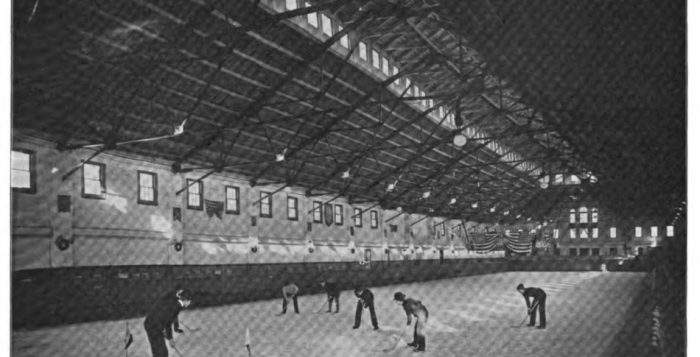This Day in Hockey History – February 14, 1896 – An Early Uni Win in the U.S.
(Photo: North Avenue Ice Palace, Ice and refrigeration 8 (1895), via Wikimedia Commons)
Like with many things in hockey’s earliest history, the claims for the first intercollegiate hockey game vary. Yale claims the first game that counted occurred on February 14, 1896. However, a game was definitely held on February 1, and the newspaper blurb about that game implied that there had already been others. Regardless, the two Yale-Johns Hopkins matches in February 1896 rank among the first documented intercollegiate hockey games.
The teams that played for the Yale University Bulldogs and the Johns Hopkins University Blue Jays were not limited to undergraduate students. John Hopkins sent out a mix of eleven graduate and undergraduate players because the graduate level had three times as many students. Their captain, a defenseman named Samuel Alfred Mitchell, studied astronomy as a grad student. Whereas, their goalie/team manager/treasurer, G. B. Scholl, was a sophomore undergraduate. As for Yale, according to one hockey history, their team could have been considered a “group of ringers, a scenario common in intercollegiate contests of the day.” Three players from an 1894-95 hockey tour played for Yale, but of them, only the captain, Malcolm Chace, actually attended Yale. The other two, William Jones and goalie William Larned (a noted tennis star), attended Brown and Columbia, respectively.
The Yale team from Connecticut came down to Baltimore to play at the North Avenue Ice Palace, which opened December 26th, 1894 as the first artificial ice surface (250 feet by 55 feet) in the U.S. The Palace only featured hockey games through 1898 before having the ice-making equipment removed in 1899. It officially closed much later, in 1932, and its location, between Charles and St. Paul Streets, became a vacant parking lot.
At the end of January in 1896, Yale played the Baltimore Athletic Club and defeated them 3-2. After reviewing that game, Yale and Johns Hopkins chose their line-ups and revealed them on January 31, 1896. On February 1, the two collegiate teams met competitively for the first time on record. The teams tied 2-2. The Baltimore Sun only devoted three sentences to the game. “Two to two was the score of the hockey match played at the North Avenue Rink Saturday night between the Johns Hopkins University team and the men from Yale. The attendance was the largest of the season. The game was most exciting from start to finish.”
On February 14, 1896, the two colleges played each other again, and for the first time documented, there was a victor. This time, the Baltimore Sun provided a more thorough recap. Johns Hopkins scored a few minutes after the game began with the “puck being carried through the Yale line by good team work and passing, Hill shooting the goal.” From that and their “fine team work” as “they fired the puck time and again,” it seemed to the reporter that Johns Hopkins would likely win. However, they were thwarted by the ““remarkable defense of Jones, who covered goal, and the fine play also of the goalkeeper, Wrenn. These made a number of sensational plays, which prevented goals being made by the Hopkins men.” Yale’s captain, Chace, scored the only other two goals of the game. According to the Baltimore Sun, “Time and again he carried the puck almost alone from near the Yale goal to within a few feet of the Hopkins goal.” When he scored, “one was made by a straight run unsided, the other he made after a double pass, Chace sending the puck to Ryder near the goal and Ryder passing it back to Chace, who then sent it into the goal.” Yale won 2-1 “after a close, hotly contested and admirably played game.”
Within a couple of years, interest in hockey waned in Baltimore. Like the closing of the rink, the Johns Hopkins team folded in 1898. Along with problems with the rink and other Baltimore teams, the college also had issues with transportation and student support. It took 90 years before Johns Hopkins again had a competitive team.
Additional Sources:
- http://archives.yalealumnimagazine.com/issues/03_02/old_yale.html
- https://mens.dvchchockey.org/page/show/1605087-johns-hopkins-
- Stephen Hardy and Andrew C. Holman, Hockey: A Global History (University of Illinois Press, 2018), kindle version.
- https://scottywazz.com/2018/02/26/maryland-hockey-history-week-first-college-game-first-artificial-ice-first-pro-team/
- http://scottywazz.blogspot.com/2010/02/baltimore-hockey-history-first-game-in.html
- http://www.brown.edu/Administration/News_Bureau/Databases/Encyclopedia/search.php?serial=H0170
- “Yale, 2; Hopkins, 1,” Baltimore Sun, 15 Feb. 1896, p. 6.















[…] to travel to Canada for a series. This finally worked to foster enthusiasm for the sport, and in February 1896, Yale traveled to Baltimore to play Johns Hopkins. Harvard and Brown played the last […]